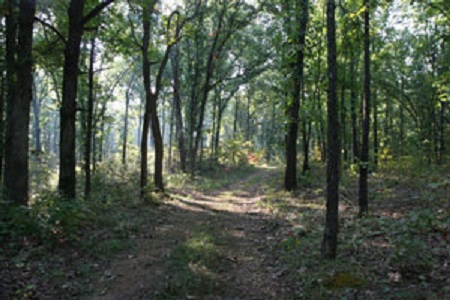
Courtesy of National Park Service
Between March 6 and 8, 1862, Union and Confederate troops met in battle at Pea Ridge in Arkansas. Even though Union forces were fighting deep in the South, they successfully defeated Confederate troops, despite being surprised and outnumbered. This important victory commemorated at Pea Ridge National Military Park ensured that Union forces controlled Missouri and the major transportation center at St. Louis throughout the Civil War. Visitors to the park can learn about the battle, about the Cherokee soldiers who fought there, and also about the Trail of Tears the Cherokee and other American Indian tribes followed when they were forced to leave their homes.
Today, Pea Ridge rises above quiet fields that show little evidence of the conflict that took place there roughly 150 years ago. The landscape is still very similar to that of the 1860s; some argue that Pea Ridge is the best-preserved Civil War battlefield. Though the battle at Pea Ridge took place in Arkansas, it served to drive pro-Confederate forces from Missouri. In two days in 1862, Federal troops defeated Confederates through superior leadership. Many of the major leaders at Pea Ridge went on to even greater successes in the US Army. Visitors to the park can learn about the people and places of Pea Ridge at the visitor center by viewing the orientation film and exhibits on the Civil War.
The battle at Pea Ridge took place just about a year after the war began in April 1861. Fighting occurred primarily at the village of Leetown and the Elkhorn Tavern. The 1835 tavern burned following the battle. A reconstructed tavern from the 1880s replacing the original cabin is in the park. During the fighting, the tavern sheltered the family who lived there and troops from both sides depending on who controlled the area. The soldiers used the tavern as both a hospital and a headquarters office. All that remains of the village of Leetown is a burial plot.
Brigadier General Samuel Curtis led Federal troops. Curtis anticipated that Confederate troops, under the direction of Major General Van Dorn, would attack him from the south. Instead, Van Dorn divided his troops. Some came from the north following Telegraph Road, and others came from the west, attacking Leetown. In deciding on this tactic, Van Dorn made a mistake. Sending his troops on ahead, he left the ammunition wagons behind. When the first day of fighting was over, Curtis and his troops were able to resupply themselves. The Confederates fell into a trap; without access to fresh supplies, they were defeated despite their numbers. Curtis received a promotion to major general following Pea Ridge.
While no scars from the battle mar the open fields at Pea Ridge National Military Park, visitors to the site will notice trenches in a separate part of the park south of the visitor center. Though Federal troops under Curtis built these trenches during the battle at Pea Ridge, troops did not use them during the struggle. They did play a role in the battle, though, as they convinced Van Dorn to attack from the north. The trench area is accessible to the public via a short interpretive walk around the site.
The area around the battlefield was a major crossroads and several roads pass through the park. One of these roads, the Springfield to Fayetteville Road, also known as Telegraph Road, passes just by the Elkhorn Tavern. Many troops marched along this road during the battle. In the late 1820s, thousands of Cherokee and other Indian tribes followed this road and passed by the tavern as the Federal Government forced them to relocate from tribal lands in the East to new land in the West. This road segment at Pea Ridge, together with other routes, forms the Trail of Tears. While visiting Elkhorn Tavern, visitors to the park can see one of the best-preserved roads along which the Cherokee traveled in the 1820s.
Some of the Confederate soldiers who fought at Pea Ridge were Cherokee who earlier traveled along the Trail of Tears as part of the relocation. One of the men who signed the treaty allowing the government to force the Cherokee west, Stand Watie, led a group of soldiers at Pea Ridge. Watie formed the Confederate 2nd Cherokee Mounted Rifles and commanded the regiment at Pea Ridge. Afterwards, he led the regiment to fight in 18 battles and major skirmishes and other minor skirmishes and raids. In 1864, he became the only American Indian promoted to brigadier general in either the Union or Confederate army. He also has the distinction of being the last Confederate general to surrender to Union soldiers.
Pea Ridge National Military Park, a unit of the National Park System, is located at 15930 E Highway 62 in Garfield, AR. Pea Ridge National Military Park and several other sites within the park are listed in the National Register of Historic Places. Click here for National Register of Historic Places registration files for Pea Ridge National Military Park (text and photos). There is a fee to enter the park. The park and visitor center are usually open 8:00am to 5:00pm daily. The park is closed on Thanksgiving, Christmas, and New Year’s Day. For more information, visit the National Park Service Pea Ridge National Military Park website or call 479-451-8122.
Elkhorn Tavern has been documented by the National Park Service’s Historic American Buildings Survey.
Riding and hiking trails are available at the park. In addition, the visitor center offers an orientation film as well as exhibits highlighting the history of the battle. An auto tour route with signs explaining the battle is also available.
Last updated: August 23, 2017
